Enabling Low-Carbon Transportation: Resilient Energy Governance via Intelligent VPP and Mobile Energy Storage-Driven V2G Solutions
Abstract
1. Introduction
1.1. Literature Review
1.1.1. Role of VPPs and Mobile ESSs
1.1.2. Linkage Technology Between EV Charging Stations and Mobile ESSs
1.1.3. V2G Technologies for Energy Conservation and Emission Reduction
1.1.4. Review Summary
1.2. Purpose of the Study
2. System Design and Analysis
2.1. V2G Solution Operation and Architecture
2.1.1. Concept and Objects of the Proposed Model
2.1.2. Structure of the Proposed Model
Service Layer
Digital Technology Layer
Infrastructure Energy Data Layer
2.1.3. Polyfunctional V2G Roles by Charging Station Type
- Residential In-Building Charging Station: Vehicles parked at night by private EV users play an important role in receiving energy via V2G. This type, in conjunction with a VPP, supplies battery energy from EVs that are not used at night to mitigate the peak of power consumption at night.
- Major City In-Building Charging Station: This type of charging station is installed in commercial facilities or public parking lots within cities for short-term use. Rather than relying on a direct power supply, it prioritizes energy distribution using a mobile ESS during periods of high demand.
- Garage In-Building Charging Station: A garage charging station where private EVs are parked long term. Energy is recovered from the battery of private EVs at night or during times of low vehicle use and supplied to the required area.
- Roadside In-Building Charging Station: An express charging station on a highway that is often used for quick charging by private EV users, which can lead to a sudden surge in demand for charging. Demand data are analyzed in advance, and energy is replenished quickly, if necessary, to respond reliably to rapid and/or large-scale energy demand.
2.2. Data Collection and Analysis
2.2.1. Analysis of Private EV-Based Mobile ESS Potential
2.2.2. Charging Station Location Data and Classification
2.2.3. Energy Demand Characteristics by Charging Station Type
3. Applied Models and Algorithm Design
3.1. Demand Management with Mobile ESSs
3.1.1. Charging Demand Management Process
3.1.2. Heuristic Load Allocation for Mobile ESS
| Algorithm 1: Heuristic Algorithm for the Distribution of Energy with a Mobile ESS |
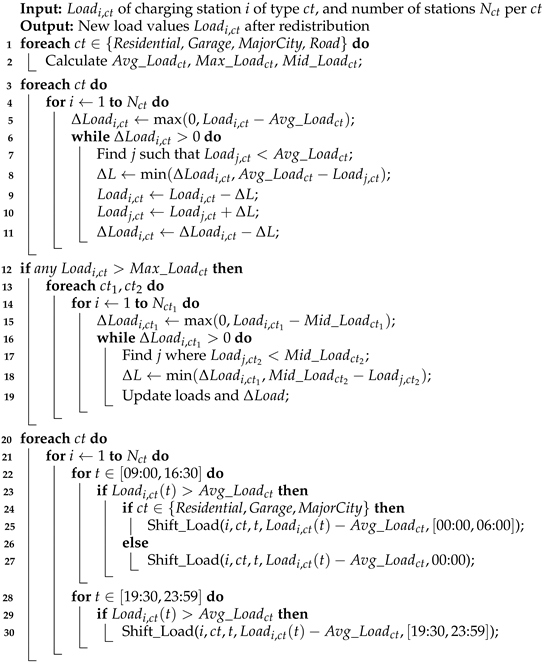 |
3.2. Machine Learning for Data-Driven VPP Design
3.2.1. K-Means Data Clustering Package Modeling
3.2.2. Data Clustering and Package Modeling Using K-Means
4. Results and Discussion
4.1. Baseline Load Analysis and Initial Energy Management
4.2. Results of Energy Distribution Using V2G Solution
4.3. Impact of the Proposed Solutions on Carbon Emissions
4.4. Economic Feasibility Analysis of the Proposed Solution
- An annual benefit exceeding the annualized cost indicates financial autonomy and operational sustainability under market or policy fluctuations.
- A high BCR demonstrates strong investment return potential and economic recoverability.
- A low LCOE enhances price elasticity, enabling cost-effective energy supply even under market volatility or supply instability.
5. Conclusions
6. Future Research
Author Contributions
Funding
Data Availability Statement
Conflicts of Interest
Abbreviations and Symbols
| BCR | Benefit–Cost Ratio |
| BEM | Building Energy Modeling |
| BIM | Building Information Modeling |
| CEF | Carbon emission factor |
| CRED | Carbon Reduction via Energy Distribution |
| DER | Distributed Energy Resource |
| ELPD | Energy Load Factor Pre-Distribution |
| ELPR | Energy Load Factor Post-Redistribution |
| ESS | Energy storage system |
| EV | Electric Vehicle |
| GJ | Gigajoule |
| IPCC | Intergovernmental Panel on Climate Change |
| KEPCO | Korea Electric Power Corporation |
| kWh | Kilowatt-hour |
| LCOE | Levelized Cost of Energy (USD/MWh) |
| LNG | Liquefied Natural Gas |
| MECST | Mobile ESS Charging by Station Type |
| MEDST | Mobile ESS Discharging by Station Type |
| MEF | Marginal Emission Factor |
| Mobile ESS | Mobile energy storage system |
| MSR | Marginal Share Ratio |
| V2G | Vehicle-to-Grid |
| VPP | Virtual Power Plant |
| Power at time t before redistribution | |
| Power at time t after redistribution | |
| Change in power at time t due to redistribution | |
| Time-step interval (h) in load factor calculations | |
| Initial centroid of the k-th cluster in K-means | |
| Set of data points in cluster i | |
| Total energy demand of cluster i | |
| Energy supplied by mobile ESS to cluster i | |
| Energy available from private EVs in cluster i | |
| Charging cycle efficiency factor | |
| Discharging cycle efficiency factor | |
| Annual total benefit (USD/year) | |
| Capital expenditure or initial investment (USD) | |
| Annual operation and maintenance cost (USD/year) | |
| T | Project duration or system lifetime (years) |
| r | Discount rate (%) |
| Annual energy supplied or saved (MWh/year) | |
| Electricity redistributed via ESS/V2G (MWh/year) | |
| Electricity market price (USD/MWh) | |
| Carbon price (USD/tonCO2) | |
| CO2 reduction (ton/year) |
References
- Castillo-Calzadilla, T.; Alonso-Vicario, A.; Borges, C.E.; Martin, C. E-Mobility in Positive Energy Districts. Buildings 2022, 12, 264. [Google Scholar] [CrossRef]
- Khalili, S.; Rantanen, E.; Bogdanov, D.; Breyer, C. Global Transportation Demand Development with Impacts on the Energy Demand and Greenhouse Gas Emissions in a Climate-Constrained World. Energies 2019, 12, 3870. [Google Scholar] [CrossRef]
- Babic, J.; Carvalho, A.; Ketter, W.; Podobnik, V. A data-driven approach to managing electric vehicle charging infrastructure in parking lots. Transp. Res. Part D Transp. Environ. 2022, 105, 103198. [Google Scholar] [CrossRef]
- Shareef, H.; Islam, M.M.; Mohamed, A. A review of the state-of-the-art charging technologies, placement methodologies, and impacts of electric vehicles. Renew. Sustain. Energy Rev. 2016, 64, 403–420. [Google Scholar] [CrossRef]
- Xie, D.; Shi, X.; Li, K.; Li, J.; Li, G. Nonlinear Impact Analysis of Urban Road Traffic Carbon Emissions Based on the Integration of Gasoline and Electric Vehicles. Buildings 2025, 15, 488. [Google Scholar] [CrossRef]
- Kapustin, N.O.; Grushevenko, D.A. Long-term electric vehicles outlook and their potential impact on electric grid. Energy Policy 2020, 137, 111103. [Google Scholar] [CrossRef]
- Haghani, M.; Sprei, F.; Kazemzadeh, K.; Shahhoseini, Z.; Aghaei, J. Trends in electric vehicles research. Transp. Res. Part D Transp. Environ. 2023, 123, 103881. [Google Scholar] [CrossRef]
- Shafiei, M.; Ghasemi-Marzbali, A. Electric vehicle fast charging station design by considering probabilistic model of renewable energy source and demand response. Energy 2023, 267, 126545. [Google Scholar] [CrossRef]
- Will, C.; Zimmermann, F.; Ensslen, A.; Fraunholz, C.; Jochem, P.; Keles, D. Can electric vehicle charging be carbon neutral? Uniting smart charging and renewables. Appl. Energy 2024, 371, 123549. [Google Scholar] [CrossRef]
- Tarafdar-Hagh, M.; Taghizad-Tavana, K.; Ghanbari-Ghalehjoughi, M.; Nojavan, S.; Jafari, P.; Mohammadpour Shotorbani, A. Optimizing Electric Vehicle Operations for a Smart Environment: A Comprehensive Review. Energies 2023, 16, 4302. [Google Scholar] [CrossRef]
- Saleh, M.; Milovanoff, A.; Daniel Posen, I.; MacLean, H.L.; Hatzopoulou, M. Energy and greenhouse gas implications of shared automated electric vehicles. Transp. Res. Part D Transp. Environ. 2022, 105, 103233. [Google Scholar] [CrossRef]
- Dik, A.; Omer, S.; Boukhanouf, R. Electric Vehicles: V2G for Rapid, Safe, and Green EV Penetration. Energies 2022, 15, 803. [Google Scholar] [CrossRef]
- Wu, Y.-C.; Kontou, E. Designing electric vehicle incentives to meet emission reduction targets. Transp. Res. Part D Transp. Environ. 2022, 107, 103320. [Google Scholar] [CrossRef]
- Yang, K.; Zhang, Q.; Wang, G.; Li, H.; McLellan, B. A new model for comprehensively evaluating the economic and environmental effects of vehicle-to-grid (V2G) towards carbon neutrality. J. Energy Storage 2024, 98, 113067. [Google Scholar] [CrossRef]
- Abdullah, H.M.; Gastli, A.; Ben-Brahim, L. Reinforcement Learning Based EV Charging Management Systems–A Review. IEEE Access 2021, 9, 41506–41531. [Google Scholar] [CrossRef]
- Leippi, A.; Fleschutz, M.; Davis, K.; Klingler, A.-L.; Murphy, M.D. Optimizing electric vehicle fleet integration in industrial demand response: Maximizing vehicle-to-grid benefits while compensating vehicle owners for battery degradation. Appl. Energy 2024, 374, 123995. [Google Scholar] [CrossRef]
- Tepe, B.; Figgener, J.; Englberger, S.; Sauer, D.U.; Jossen, A.; Hesse, H. Optimal pool composition of commercial electric vehicles in V2G fleet operation of various electricity markets. Appl. Energy 2022, 308, 118351. [Google Scholar] [CrossRef]
- Muttaqi, K.M.; Isac, E.; Mandal, A.; Sutanto, D.; Akter, S. Fast and random charging of electric vehicles and its impacts: State-of-the-art technologies and case studies. Electr. Power Syst. Res. 2024, 226, 109899. [Google Scholar] [CrossRef]
- He, Z.; Khazaei, J.; Freihaut, J.D. Optimal integration of Vehicle to Building (V2B) and Building to Vehicle (B2V) technologies for commercial buildings. Sustain. Energy Grids Netw. 2022, 32, 100921. [Google Scholar] [CrossRef]
- Liao, Z.; Taiebat, M.; Xu, M. Shared autonomous electric vehicle fleets with vehicle-to-grid capability: Economic viability and environmental co-benefits. Appl. Energy 2021, 302, 117500. [Google Scholar] [CrossRef]
- Zhang, C.; Greenblatt, J.B.; MacDougall, P.; Saxena, S.; Jayam Prabhakar, A. Quantifying the benefits of electric vehicles on the future electricity grid in the midwestern United States. Appl. Energy 2020, 270, 115174. [Google Scholar] [CrossRef]
- Varone, A.; Heilmann, Z.; Porruvecchio, G.; Romanino, A. Solar parking lot management: An IoT platform for smart charging EV fleets, using real-time data and production forecasts. Renew. Sustain. Energy Rev. 2024, 189, 113845. [Google Scholar] [CrossRef]
- Erdinc, O.; Paterakis, N.G.; Mendes, T.D.P.; Bakirtzis, A.G.; Catalao, J.P.S. Smart Household Operation Considering Bi-Directional EV and ESS Utilization by Real-Time Pricing-Based DR. IEEE Trans. Smart Grid 2015, 6, 1281–1291. [Google Scholar] [CrossRef]
- Alabi, T.M.; Lu, L.; Yang, Z. Improved hybrid inexact optimal scheduling of virtual powerplant (VPP) for zero-carbon multi-energy system (ZCMES) incorporating Electric Vehicle (EV) multi-flexible approach. J. Clean. Prod. 2021, 326, 129294. [Google Scholar] [CrossRef]
- İnci, M.; Savrun, M.M.; Özgür, Ç. Integrating electric vehicles as virtual power plants: A comprehensive review on vehicle-to-grid (V2G) concepts, interface topologies, marketing and future prospects. J. Energy Storage 2022, 55, 105579. [Google Scholar] [CrossRef]
- Türkoğlu, A.S.; Güldorum, H.C.; Şengor, I.; İçek, A.; Erdinç, O.; Hayes, B.P. Maximizing EV profit and grid stability through Virtual Power Plant considering V2G. Energy Rep. 2024, 11, 3509–3520. [Google Scholar] [CrossRef]
- Palmiotto, F.; Zhou, Y.; Forte, G.; Dicorato, M.; Trovato, M.; Cipcigan, L.M. A coordinated optimal programming scheme for an electric vehicle fleet in the residential sector. Sustain. Energy Grids Netw. 2021, 28, 100550. [Google Scholar] [CrossRef]
- Mwasilu, F.; Justo, J.J.; Kim, E.-K.; Do, T.D.; Jung, J.-W. Electric vehicles and smart grid interaction: A review on vehicle to grid and renewable energy sources integration. Renew. Sustain. Energy Rev. 2014, 34, 501–516. [Google Scholar] [CrossRef]
- Lebrouhi, B.E.; Khattari, Y.; Lamrani, B.; Maaroufi, M.; Zeraouli, Y.; Kousksou, T. Key challenges for a large-scale development of battery electric vehicles: A comprehensive review. J. Energy Storage 2021, 44, 103273. [Google Scholar] [CrossRef]
- Ramadhani, U.H.; Fachrizal, R.; Shepero, M.; Munkhammar, J.; Widén, J. Probabilistic load flow analysis of electric vehicle smart charging in unbalanced LV distribution systems with residential photovoltaic generation. Sustain. Cities Soc. 2021, 72, 103043. [Google Scholar] [CrossRef]
- Soares, J.; Morais, H.; Sousa, T.; Vale, Z.; Faria, P. Day-Ahead Resource Scheduling Including Demand Response for Electric Vehicles. IEEE Trans. Smart Grid 2013, 4, 596–605. [Google Scholar] [CrossRef]
- Sarda, J.; Patel, N.; Patel, H.; Vaghela, R.; Brahma, B.; Bhoi, A.K.; Barsocchi, P. A review of the electric vehicle charging technology, impact on grid integration, policy consequences, challenges and future trends. Energy Rep. 2024, 12, 5671–5692. [Google Scholar] [CrossRef]
- Kumar, G.M.S.; Cao, S. Conversion of metro railway into smart charging zero-emission transportation hub for supporting electric train, shuttle bus, cars and public EV charging station. Energy Convers. Manag. X 2024, 22, 100552. [Google Scholar] [CrossRef]
- Dong, X.-J.; Shen, J.-N.; Liu, C.-W.; Ma, Z.-F.; He, Y.-J. Simultaneous capacity configuration and scheduling optimization of an integrated electrical vehicle charging station with photovoltaic and battery energy storage system. Energy 2024, 289, 129991. [Google Scholar] [CrossRef]
- Cao, S. The impact of electric vehicles and mobile boundary expansions on the realization of zero-emission office buildings. Appl. Energy 2019, 251, 113347. [Google Scholar] [CrossRef]
- Liu, B.; Zhuo, F.; Zhu, Y.; Yi, H. System Operation and Energy Management of a Renewable Energy-Based DC Micro-Grid for High Penetration Depth Application. IEEE Trans. Smart Grid 2015, 6, 1147–1155. [Google Scholar] [CrossRef]
- Choi, M.; Kang, B.; Lee, S.; Park, S.; Beck, J.S.; Lee, S.H.; Park, S. Empirical study on optimization methods of building energy operation for the sustainability of buildings with integrated renewable energy. Energy Build. 2024, 305, 113908. [Google Scholar] [CrossRef]
- Damianakis, N.; Mouli, G.R.C.; Bauer, P. Grid impact of photovoltaics, electric vehicles and heat pumps on distribution grids—An overview. Appl. Energy 2025, 380, 125000. [Google Scholar] [CrossRef]
- Morrissey, P.; Weldon, P.; O’Mahony, M. Future standard and fast charging infrastructure planning: An analysis of electric vehicle charging behaviour. Energy Policy 2016, 89, 257–270. [Google Scholar] [CrossRef]
- Lee, T.; Yoon, G.; Kang, B.; Choi, M.; Park, S.; Park, J.; Park, S. Enhancing Electric Vehicle Charging Infrastructure: A Techno-Economic Analysis of Distributed Energy Resources and Local Grid Integration. Buildings 2024, 14, 2546. [Google Scholar] [CrossRef]
- Yang, J.; Wu, F.; Yan, J.; Lin, Y.; Zhan, X.; Chen, L.; Liao, S.; Xu, J.; Sun, Y. Charging demand analysis framework for electric vehicles considering the bounded rationality behavior of users. Int. J. Electr. Power Energy Syst. 2020, 119, 105952. [Google Scholar] [CrossRef]
- Yang, D.; Sarma, N.J.S.; Hyland, M.F.; Jayakrishnan, R. Dynamic modeling and real-time management of a system of EV fast-charging stations. Transp. Res. Part C Emerg. Technol. 2021, 128, 103186. [Google Scholar] [CrossRef]
- Demirci, A.; Tercan, S.M.; Cali, U.; Nakir, I. A Comprehensive Data Analysis of Electric Vehicle User Behaviors Toward Unlocking Vehicle-to-Grid Potential. IEEE Access 2023, 11, 9149–9165. [Google Scholar] [CrossRef]
- Menghwar, M.; Yan, J.; Chi, Y.; Amin, M.A.; Liu, Y. A market-based real-time algorithm for congestion alleviation incorporating EV demand response in active distribution networks. Appl. Energy 2024, 356, 122426. [Google Scholar] [CrossRef]
- Zhao, Y.; Jiang, Z.; Chen, X.; Liu, P.; Peng, T.; Shu, Z. Toward environmental sustainability: Data-driven analysis of energy use patterns and load profiles for urban electric vehicle fleets. Energy 2023, 285, 129465. [Google Scholar] [CrossRef]
- Lu, J.; Yin, W.; Wang, P.; Ji, J. EV charging load forecasting and optimal scheduling based on travel characteristics. Energy 2024, 311, 133389. [Google Scholar] [CrossRef]
- Bouguerra, S.; Bhar Layeb, S. Determining optimal deployment of electric vehicles charging stations: Case of Tunis City, Tunisia. Case Stud. Transp. Policy 2019, 7, 628–642. [Google Scholar] [CrossRef]
- Shariatzadeh, M.; Antunes, C.H.; Lopes, M.A.R. Charging scheduling in a workplace parking lot: Bi-objective optimization approaches through predictive analytics of electric vehicle users’ charging behavior. Sustain. Energy Grids Netw. 2024, 39, 101463. [Google Scholar] [CrossRef]
- Hammam, A.H.; Nayel, M.A.; Mohamed, M.A. Optimal design of sizing and allocations for highway electric vehicle charging stations based on a PV system. Appl. Energy 2024, 376, 124284. [Google Scholar] [CrossRef]
- Chen, Y.; Niu, Y.; Qu, C.; Du, M.; Wang, J. Data-driven-based distributionally robust optimization approach for a virtual power plant considering the responsiveness of electric vehicles and Ladder-type carbon trading. Int. J. Electr. Power Energy Syst. 2024, 157, 109893. [Google Scholar] [CrossRef]
- Tian, X.; Zha, H.; Tian, Z.; Lang, G.; Li, L. Carbon emission reduction capability assessment based on synergistic optimization control of electric vehicle V2G and multiple types power supply. Energy Rep. 2024, 11, 1191–1198. [Google Scholar] [CrossRef]
- Rehman, M.A.; Numan, M.; Tahir, H.; Rahman, U.; Khan, M.W.; Iftikhar, M.Z. A comprehensive overview of vehicle to everything (V2X) technology for sustainable EV adoption. J. Energy Storage 2023, 74, 109304. [Google Scholar] [CrossRef]
- Ruan, G.; Qiu, D.; Sivaranjani, S.; Awad, A.S.A.; Strbac, G. Data-driven energy management of virtual power plants: A review. Adv. Appl. Energy 2024, 14, 100170. [Google Scholar] [CrossRef]
- Huang, S.; Liu, W.; Zhang, J.; Liu, C.; Sun, H.; Liao, Q. Vehicle-to-grid workplace discharging economics as a function of driving distance and type of electric vehicle. Sustain. Energy Grids Netw. 2022, 31, 100779. [Google Scholar] [CrossRef]
- Ding, T.; Zeng, Z.; Bai, J.; Qin, B.; Yang, Y.; Shahidehpour, M. Optimal Electric Vehicle Charging Strategy With Markov Decision Process and Reinforcement Learning Technique. IEEE Trans. Ind. Appl. 2020, 56, 5811–5823. [Google Scholar] [CrossRef]
- Schram, W.L.; Aghaie, H.; Lampropoulos, I.; van Sark, W.G.J.H.M. Insights on the capacity value of photovoltaics, community batteries and electric vehicles. Sustain. Energy Grids Netw. 2021, 26, 100421. [Google Scholar] [CrossRef]
- Zakariazadeh, A.; Jadid, S.; Siano, P. Integrated operation of electric vehicles and renewable generation in a smart distribution system. Energy Convers. Manag. 2015, 89, 99–110. [Google Scholar] [CrossRef]
- Niu, J.; Li, X.; Tian, Z.; Yang, H. Uncertainty analysis of the electric vehicle potential for a household to enhance robustness in decision on the EV/V2H technologies. Appl. Energy 2024, 365, 123294. [Google Scholar] [CrossRef]
- Bie, Y.; Qin, W.; Wu, J. Optimal electric bus scheduling method under hybrid energy supply mode of photovoltaic-energy storage system-power grid. Appl. Energy 2024, 372, 123774. [Google Scholar] [CrossRef]
- Wang, A.; Gao, X.; Tang, M. A space variable-scale scheduling method for digital vehicle-to-grid platform under distributed electric energy storage. Appl. Soft Comput. 2023, 133, 109911. [Google Scholar] [CrossRef]
- Yu, H.; Niu, S.; Shang, Y.; Shao, Z.; Jia, Y.; Jian, L. Electric vehicles integration and vehicle-to-grid operation in active distribution grids: A comprehensive review on power architectures, grid connection standards and typical applications. Renew. Sustain. Energy Rev. 2022, 168, 112812. [Google Scholar] [CrossRef]
- Lo, K.-Y.; Yeoh, J.H.; Hsieh, I.-Y.L. Towards Nearly Zero-Energy Buildings: Smart Energy Management of Vehicle-to-Building (V2B) Strategy and Renewable Energy Sources. Sustain. Cities Soc. 2023, 99, 104941. [Google Scholar] [CrossRef]
- Ucer, E.; Koyuncu, I.; Kisacikoglu, M.C.; Yavuz, M.; Meintz, A.; Rames, C. Modeling and Analysis of a Fast Charging Station and Evaluation of Service Quality for Electric Vehicles. IEEE Trans. Transp. Electrif. 2019, 5, 215–225. [Google Scholar] [CrossRef]
- Durdyev, S.; Dehdasht, G.; Mohandes, S.R.; Edwards, D.J. Review of the Building Information Modelling (BIM) Implementation in the Context of Building Energy Assessment. Energies 2021, 14, 8487. [Google Scholar] [CrossRef]
- Choi, H.-S. Experimental Infrastructure Design for Energy-Independent Car Park Building Based on Parametric Photovoltaic Facade System. Appl. Sci. 2024, 14, 8448. [Google Scholar] [CrossRef]
- Winschermann, L.; Bañol Arias, N.; Hoogsteen, G.; Hurink, J. Assessing the value of information for electric vehicle charging strategies at office buildings. Renew. Sustain. Energy Rev. 2023, 185, 113600. [Google Scholar] [CrossRef]
- Motalebi, M.; Rashidi, A.; Nasiri, M.M. Optimization and BIM-based lifecycle assessment integration for energy efficiency retrofit of buildings. J. Build. Eng. 2022, 49, 104022. [Google Scholar] [CrossRef]
- Ciccozzi, A.; Santavicca, A.; de Rubeis, T.; Ambrosini, D. BIM-BEM interoperability for energy analysis: A comparative study of different strategies. Energy Rep. 2025, 13, 4705–4718. [Google Scholar] [CrossRef]
- Bañol Arias, N.; Hashemi, S.; Andersen, P.B.; Træholt, C.; Romero, R. Assessment of economic benefits for EV owners participating in the primary frequency regulation markets. Int. J. Electr. Power Energy Syst. 2020, 120, 105985. [Google Scholar] [CrossRef]
- Khowaja, A.; Dean, M.D.; Kockelman, K.M. Quantifying the emissions impact of repurposed electric vehicle battery packs in residential settings. J. Energy Storage 2022, 47, 103628. [Google Scholar] [CrossRef]
- IPCC. 2006 IPCC Guidelines for National Greenhouse Gas Inventories, Volume 2: Energy; Eggleston, H.S., Buendia, L., Miwa, K., Ngara, T., Tanabe, K., Eds.; Institute for Global Environmental Strategies (IGES): Hayama, Japan, 2006; Chapter 2: Stationary Combustion. [Google Scholar]
- U.S. Environmental Protection Agency. Report on the Social Cost of Greenhouse Gases: Estimates Incorporating Recent Scientific Advances; U.S. Environmental Protection Agency: Washington, DC, USA, 2023.
- Korea Power Exchange. System Marginal Price (SMP) Statistics Portal; Korea Power Exchange: Seoul, Republic of Korea, 2024. [Google Scholar]
- U.S. Department of Energy. Battery Electric Vehicles Have Lower Scheduled Maintenance Costs; U.S. Department of Energy: Washington, DC, USA, 2021.
- Alternative Fuels Data Center. Operation and Maintenance for Electric Vehicle Charging Infrastructure; U.S. Department of Energy: Washington, DC, USA, 2023.
- U.S. Department of Energy. DOE FY 2025 Budget Justification, Volume 4; Office of the Chief Financial Officer: Washington, DC, USA, 2024.

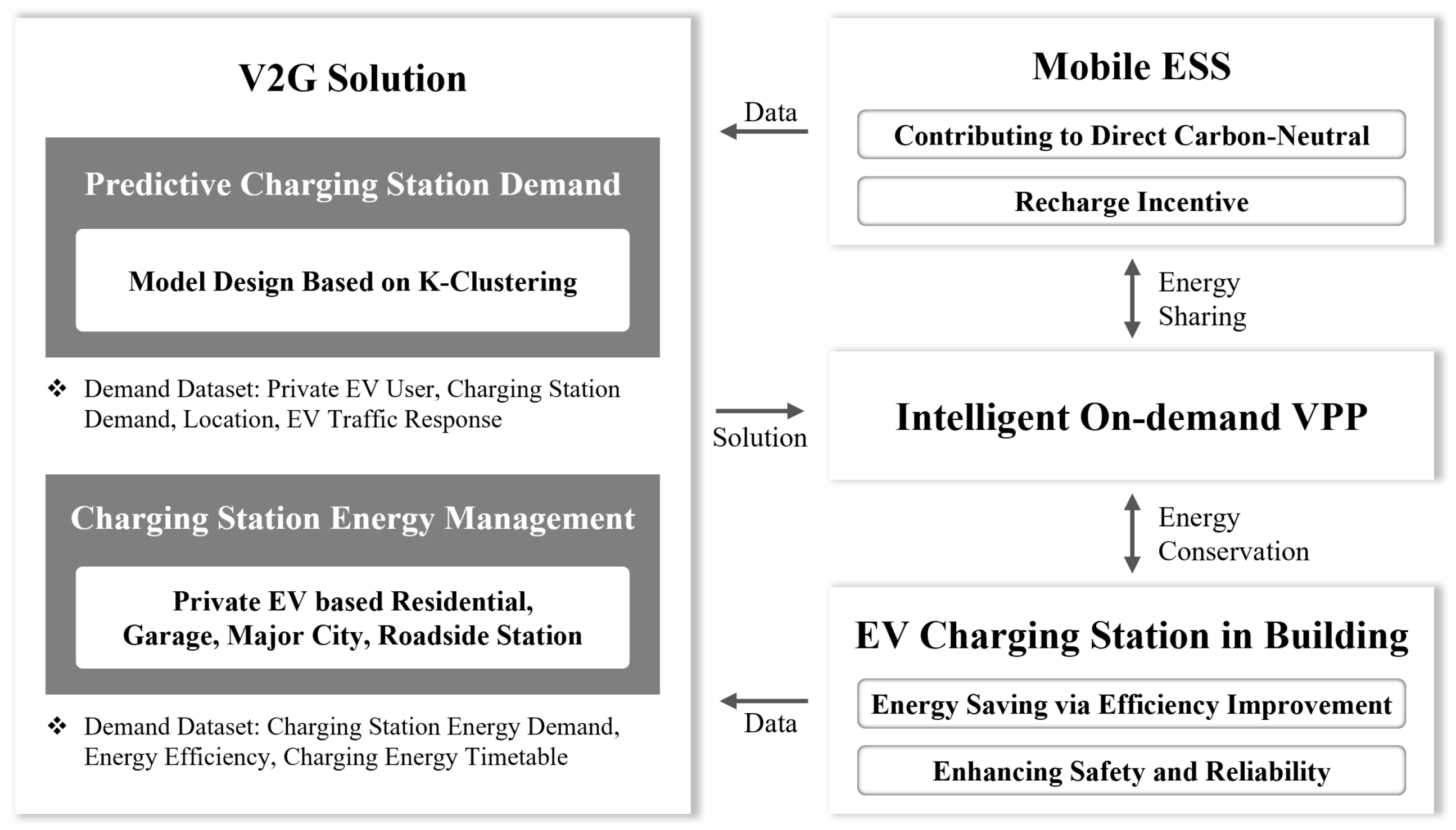
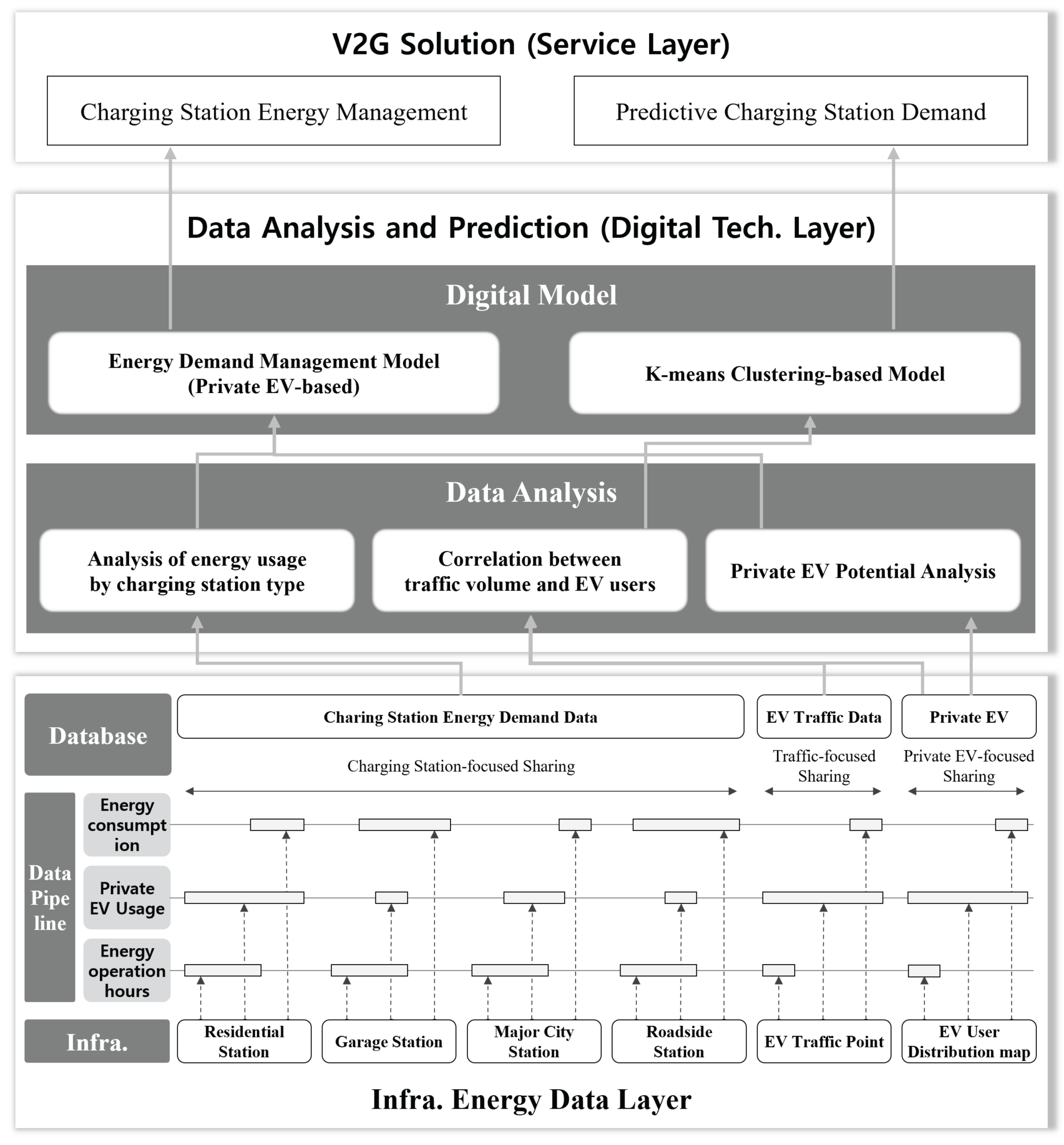
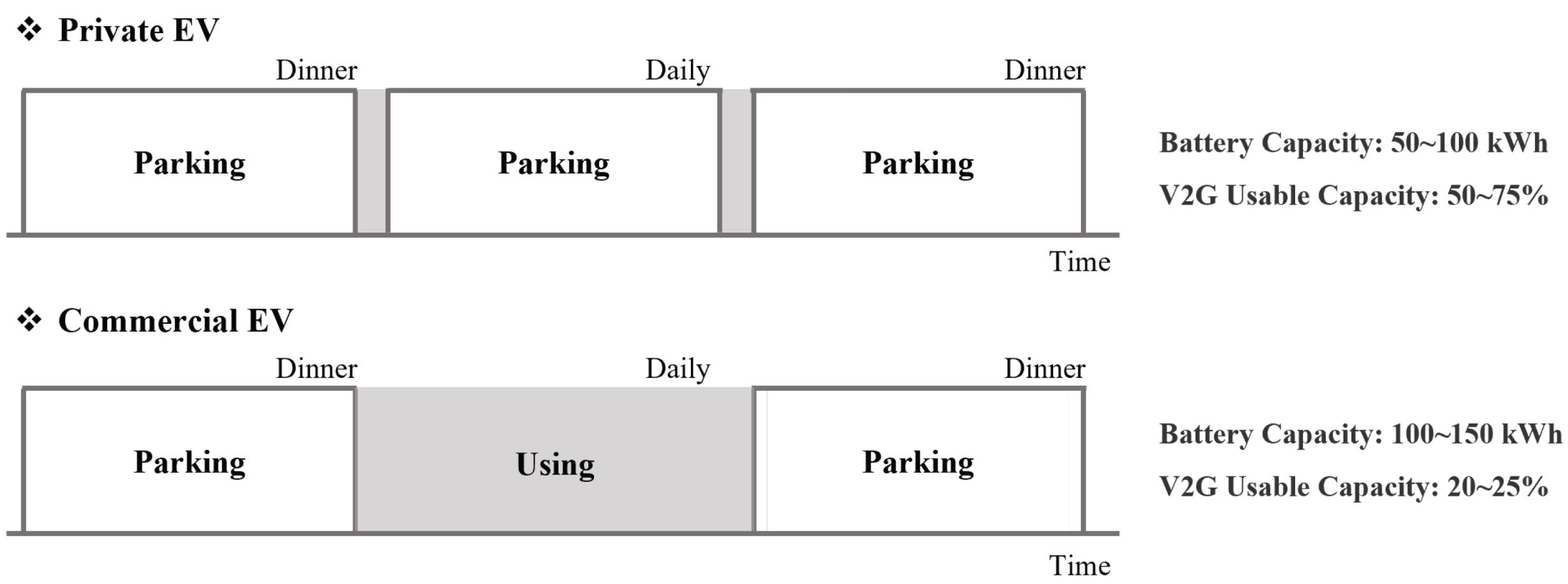
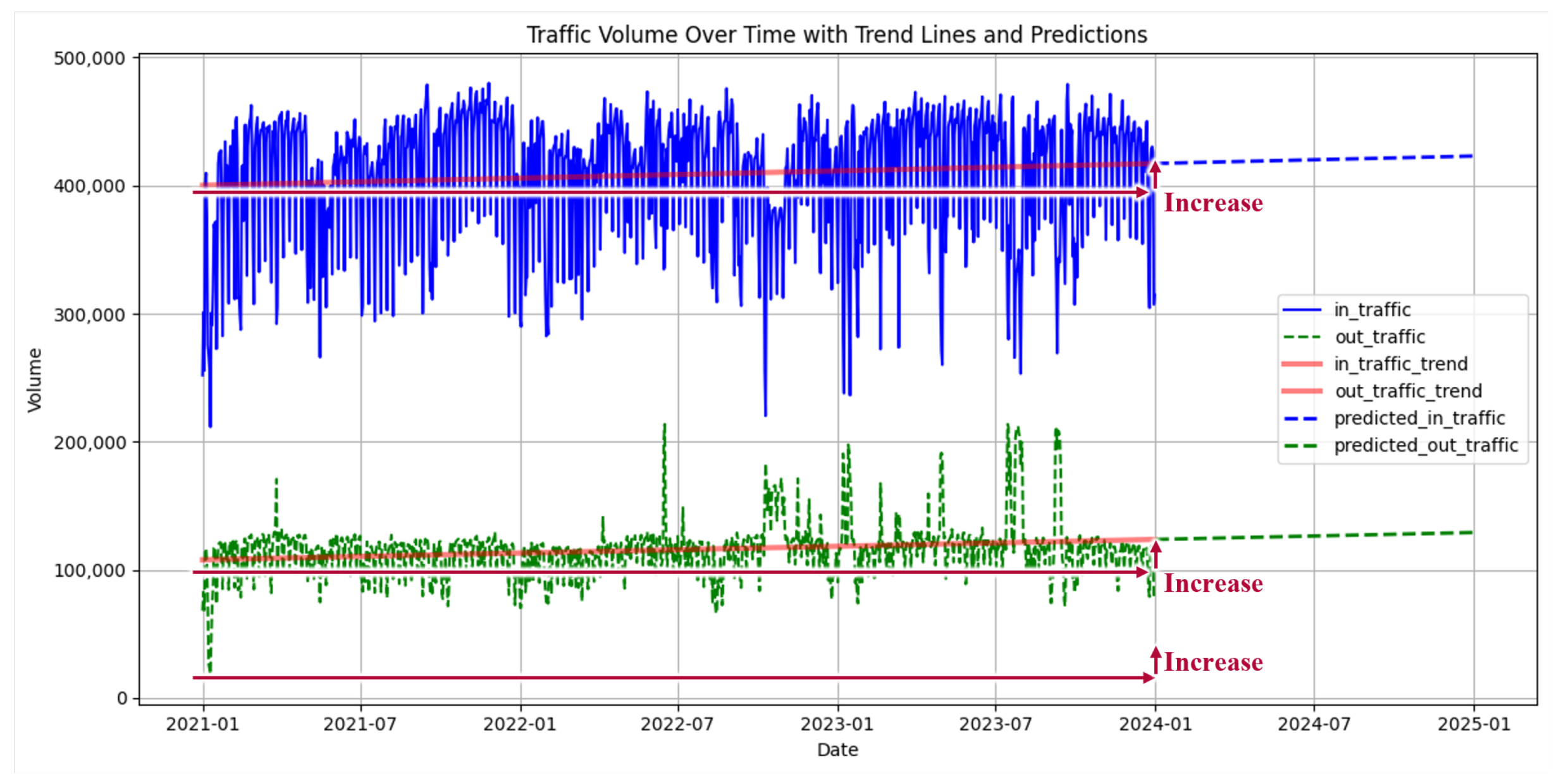
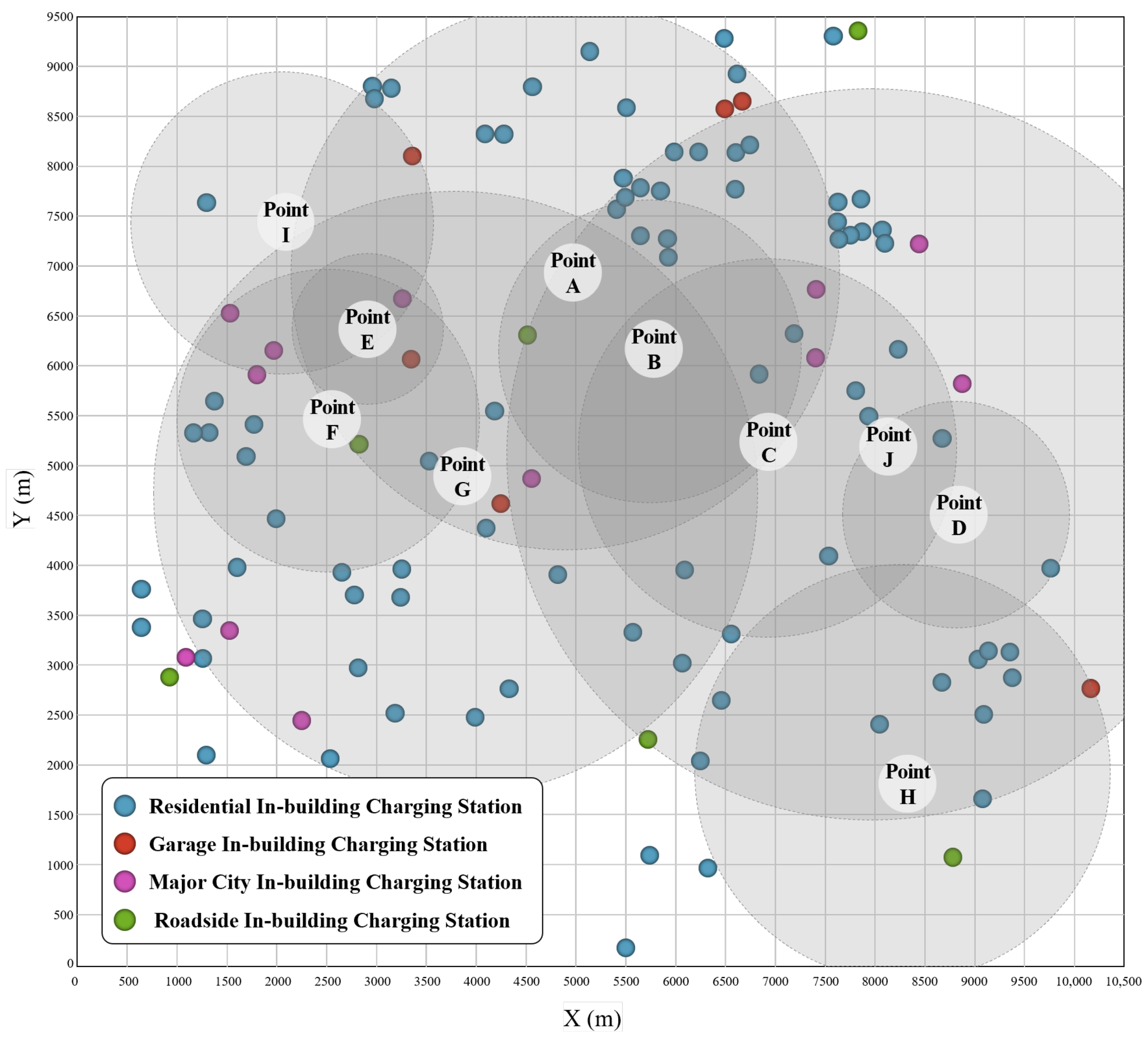
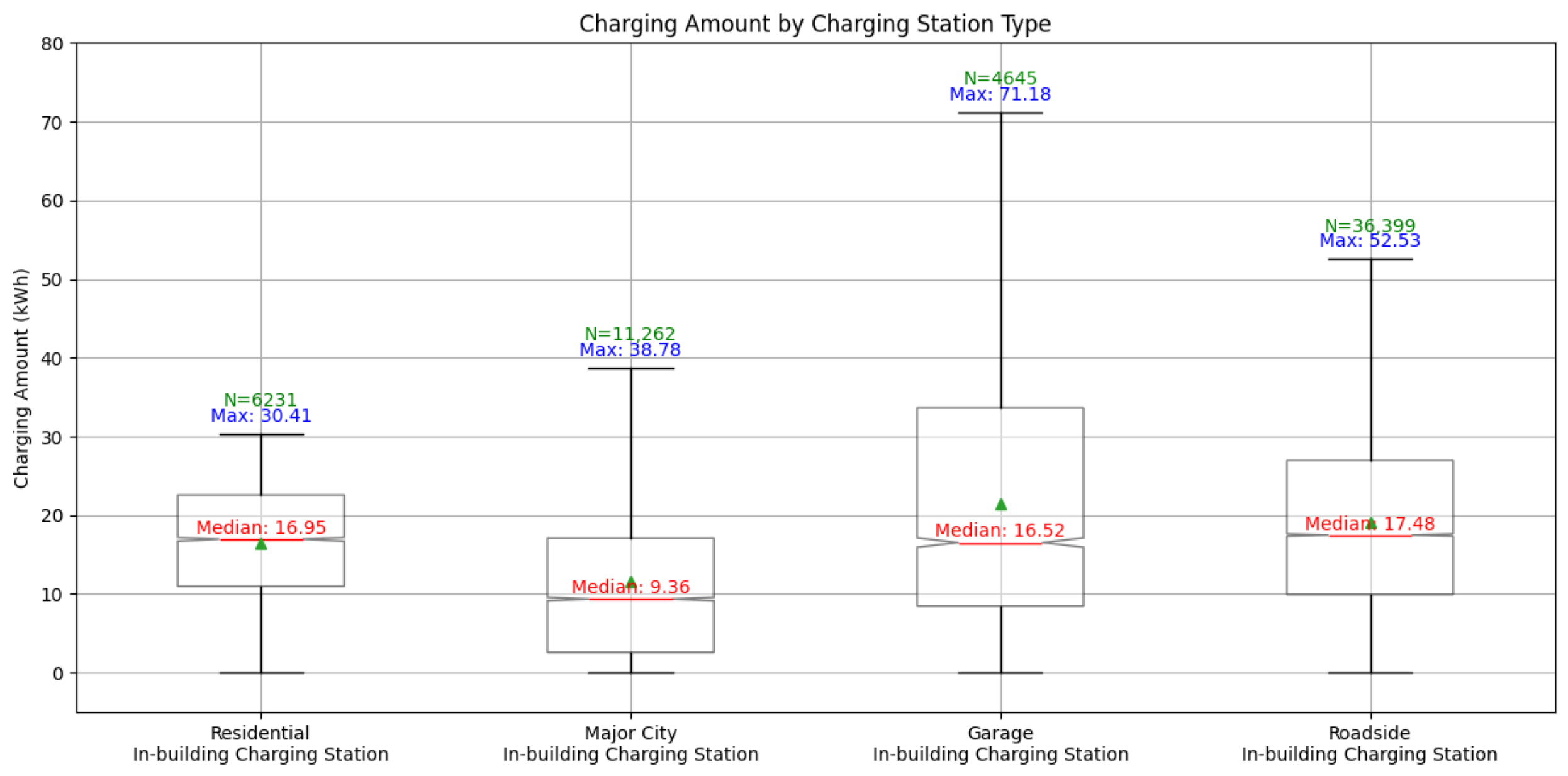
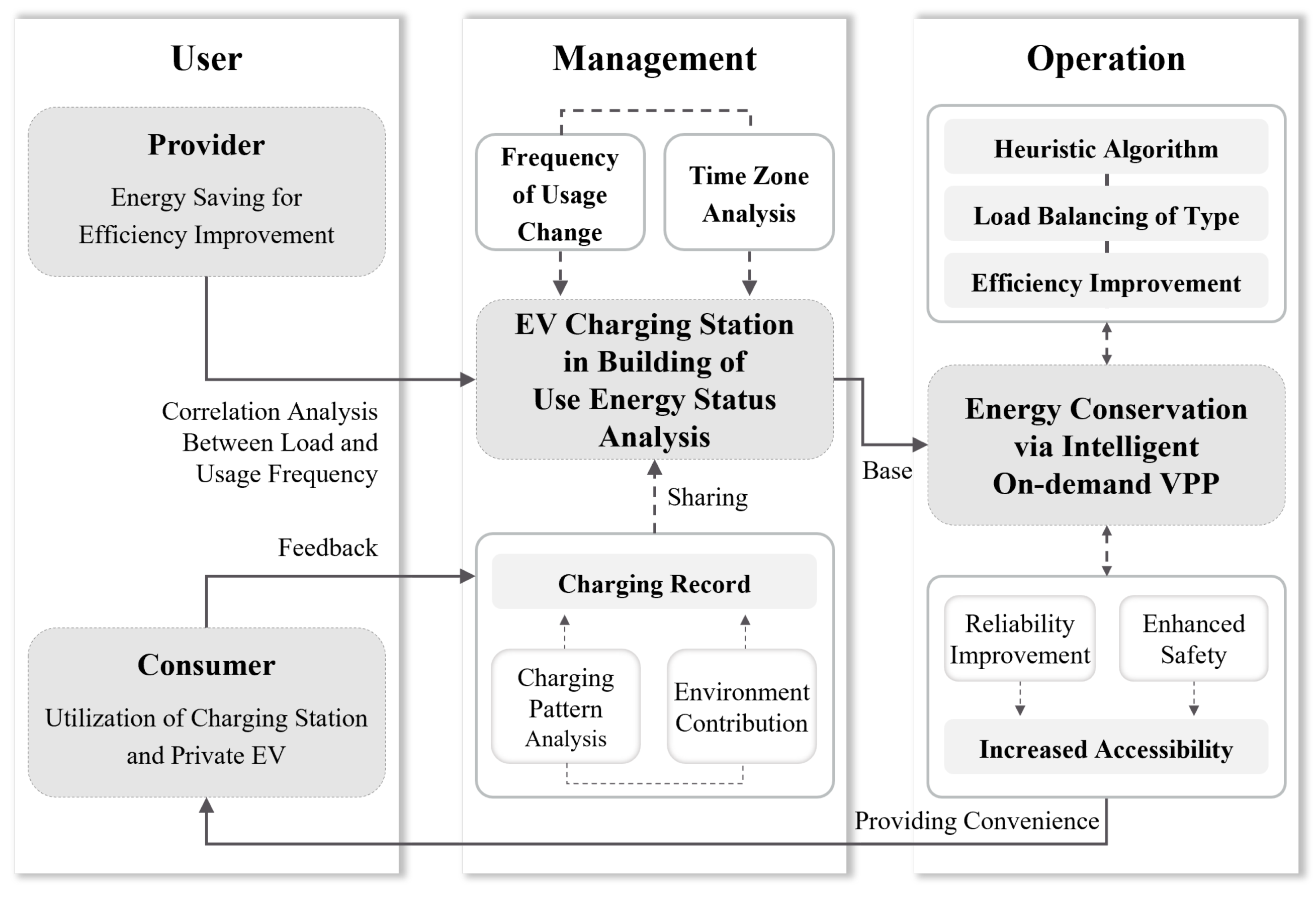
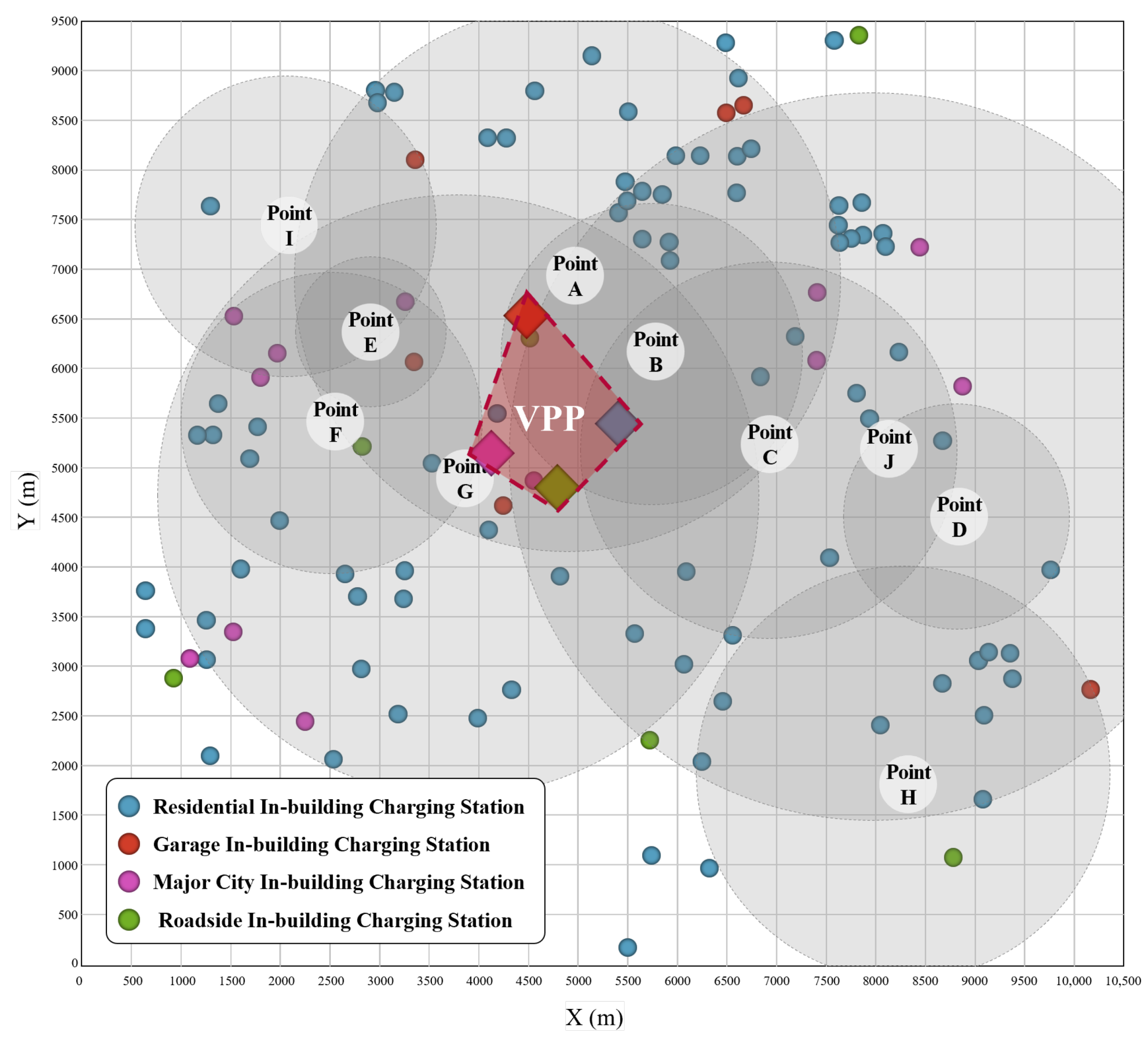
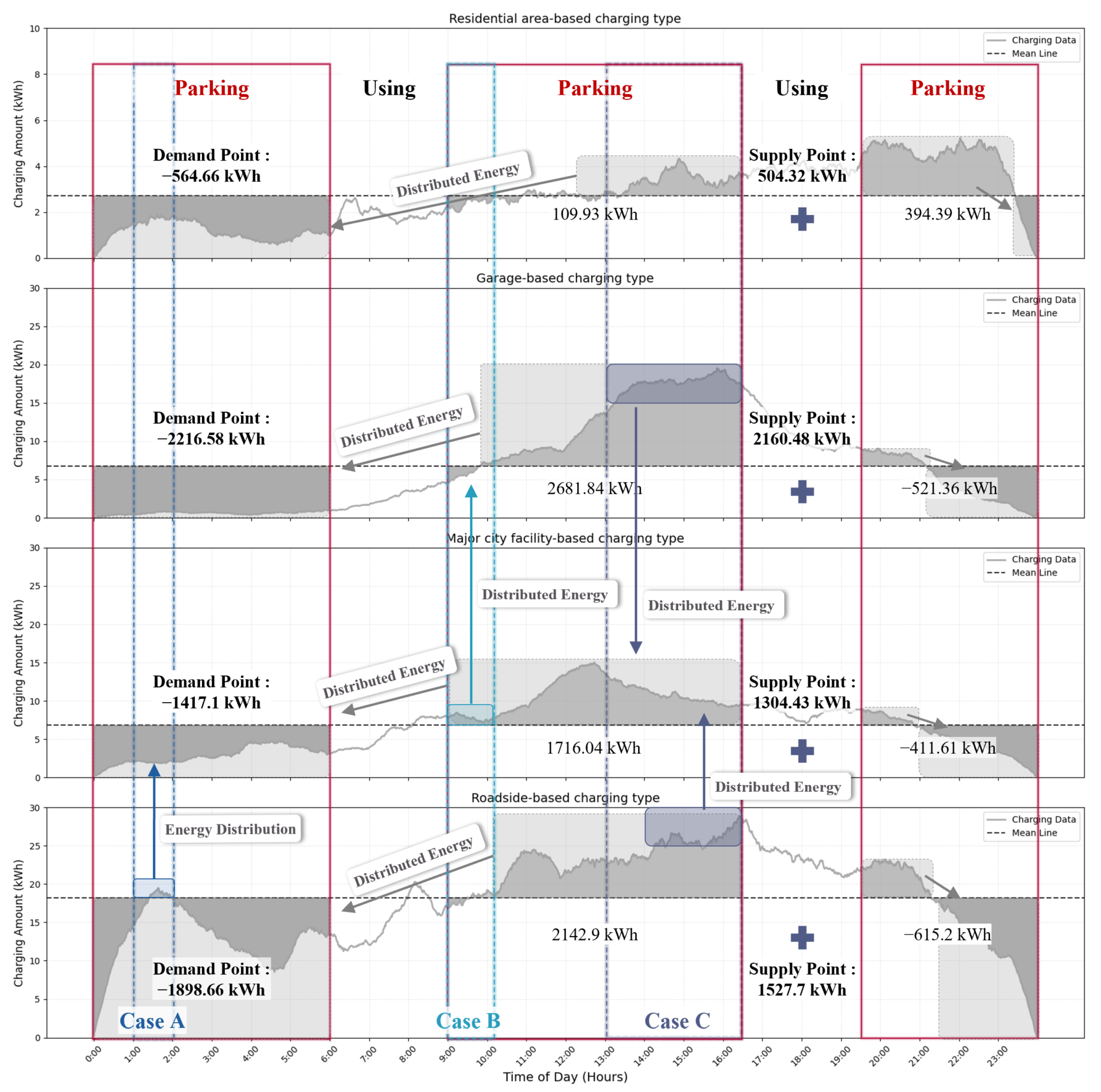

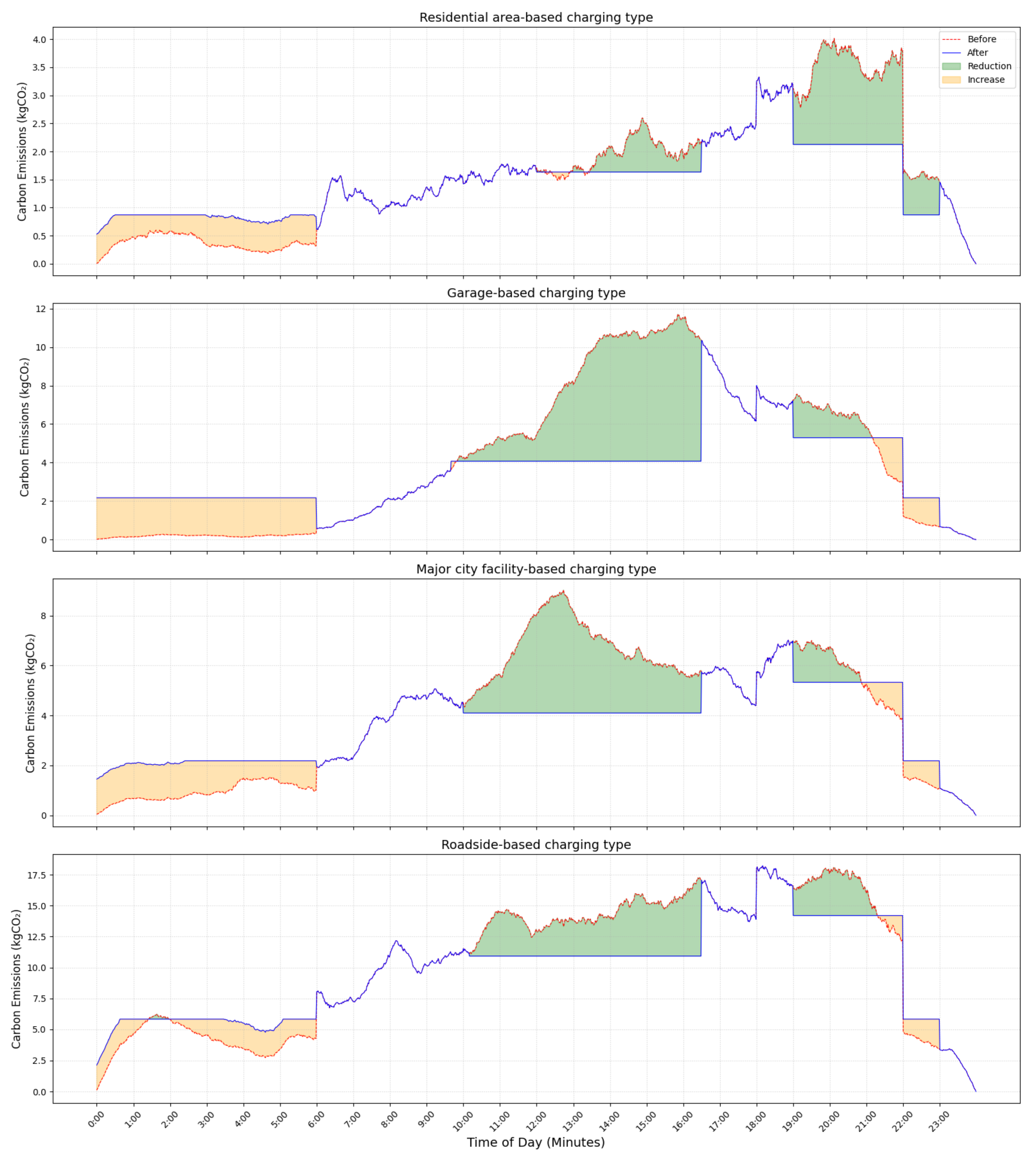
| Time Slot | 00:00–06:00 | 06:00–18:00 | 18:00–22:00 | 22:00–24:00 |
| MEF () | 0.32 | 0.60 | 0.78 | 0.32 |
| Item | Symbol | Value | Description |
|---|---|---|---|
| Annual CO2 Reduction | 271.5 | Reduction based on EV charging load shift | |
| Carbon Price [72] | 100 | Market or SCC-based unit price | |
| Shifted Electricity | 190 | Electricity redistributed via ESS and V2G | |
| Electricity Market Price [73] | 109 | System marginal price (SMP) average | |
| Initial Infrastructure Cost | 45,000 | V2G chargers and mobile ESS infra cost | |
| Annual O&M Cost [74,75] | OpEx | 1350 | Operation and maintenance |
| System Lifetime | T | 10 | Project evaluation period |
| Discount Rate [76] | r | 5 | Commonly used for ESS/LCOE assessments |
| Annual Energy Supplied | 190 | Estimated annual energy benefit |
Disclaimer/Publisher’s Note: The statements, opinions and data contained in all publications are solely those of the individual author(s) and contributor(s) and not of MDPI and/or the editor(s). MDPI and/or the editor(s) disclaim responsibility for any injury to people or property resulting from any ideas, methods, instructions or products referred to in the content. |
© 2025 by the authors. Licensee MDPI, Basel, Switzerland. This article is an open access article distributed under the terms and conditions of the Creative Commons Attribution (CC BY) license (https://creativecommons.org/licenses/by/4.0/).
Share and Cite
Yoon, G.; Choi, M.-i.; Cho, K.; Kim, S.; Lee, A.; Park, S. Enabling Low-Carbon Transportation: Resilient Energy Governance via Intelligent VPP and Mobile Energy Storage-Driven V2G Solutions. Buildings 2025, 15, 2045. https://doi.org/10.3390/buildings15122045
Yoon G, Choi M-i, Cho K, Kim S, Lee A, Park S. Enabling Low-Carbon Transportation: Resilient Energy Governance via Intelligent VPP and Mobile Energy Storage-Driven V2G Solutions. Buildings. 2025; 15(12):2045. https://doi.org/10.3390/buildings15122045
Chicago/Turabian StyleYoon, Guwon, Myeong-in Choi, Keonhee Cho, Seunghwan Kim, Ayoung Lee, and Sehyun Park. 2025. "Enabling Low-Carbon Transportation: Resilient Energy Governance via Intelligent VPP and Mobile Energy Storage-Driven V2G Solutions" Buildings 15, no. 12: 2045. https://doi.org/10.3390/buildings15122045
APA StyleYoon, G., Choi, M.-i., Cho, K., Kim, S., Lee, A., & Park, S. (2025). Enabling Low-Carbon Transportation: Resilient Energy Governance via Intelligent VPP and Mobile Energy Storage-Driven V2G Solutions. Buildings, 15(12), 2045. https://doi.org/10.3390/buildings15122045







